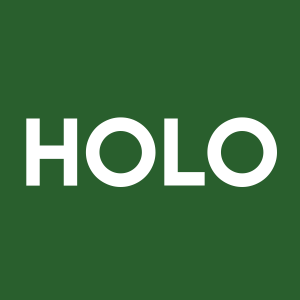Welcome to our dedicated page for MicroCloud Hologram news (Ticker: HOLO), a resource for investors and traders seeking the latest updates and insights on MicroCloud Hologram stock.
MicroCloud Hologram Inc (NASDAQ: HOLO) pioneers cutting-edge holographic technology solutions and quantum computing innovations. This news hub provides investors and industry professionals with essential updates on the company's advancements in digital twin systems, quantum encryption protocols, and AI-integrated holographic platforms.
Access authoritative coverage of HOLO's strategic developments including product launches, research breakthroughs, and partnership announcements. Our curated collection features press releases and analysis on key initiatives such as quantum convolutional neural networks, holographic LiDAR systems, and quantum blockchain security solutions.
Stay informed about critical updates including earnings reports, technology patents, and industry-specific applications in healthcare imaging, autonomous vehicle systems, and secure data transmission. Regular updates ensure comprehensive tracking of HOLO's progress in merging holographic visualization with quantum computing capabilities.
Bookmark this page for continuous access to verified information about HOLO's innovations in quantum homomorphic encryption, digital twin resource libraries, and advanced spatial mapping technologies. Check back regularly to monitor the company's position at the forefront of holographic AI and quantum-enhanced security solutions.
MicroCloud Hologram (NASDAQ: HOLO) announced a quantum-driven 3D intelligent model that integrates quantum computing and AI to auto-generate high-precision 3D models and images with reduced manual intervention. The system uses a quantum-optimized distributed architecture of six core subsystems: quantum-enhanced data acquisition, quantum-accelerated model training, quantum intelligent autonomous generation, quantum secure data management, quantum-empowered data visualization, and quantum-fortified system security.
The company reports cash reserves exceeding 3 billion RMB and plans to invest over 400 million USD from cash reserves into blockchain, quantum computing, quantum holography, and related AI/AR development.
MicroCloud Hologram (NASDAQ: HOLO) on November 20, 2025 proposed a new "quantum degree" concept to quantify synchronization in quantum systems.
The framework uses the number of synchronized non-commuting observables as a measurement standard and reports experimental implementation on a two weakly interacting cavity qubit system platform monitoring Pauli operator expectation values. Company positions the method as compatible with existing synchronization measures and applicable to quantum computing, quantum sensors, and quantum communications, with particular mention of superconducting quantum circuits.
The release also states cash reserves exceed 3 billion RMB and a plan to invest over 400 million USD from those reserves into blockchain, quantum computing, quantum holography, and related frontier technologies.
MicroCloud Hologram (NASDAQ: HOLO) announced development of a quantum-empowered big data real-time computing system that integrates quantum sensing, quantum error correction, a quantum-enhanced real-time computing engine, a quantum algorithm library, quantum visualization, and a distributed fault-tolerant architecture.
The release cites specific performance claims: data cleaning reduced from hour-level to minute-level, computational energy efficiency improved by ~3 orders of magnitude, model training speed improved by ~40%, and the company reports cash reserves exceeding 3 billion RMB with plans to invest over 400 million USD in quantum, blockchain, and related technologies.
MicroCloud Hologram (NASDAQ: HOLO) announced a next-generation quantum convolutional neural network (QCNN) multi-class classification method using a hybrid quantum-classical training framework on Nov 14, 2025.
The system encodes MNIST samples using 8 qubits plus 4 auxiliary qubits, introduces a quantum perceptron and optimized entanglement layers, and reports QCNN accuracy comparable to classical CNNs at the same parameter scale for a four-class task. The company also disclosed cash reserves >3 billion RMB and plans to invest over $400 million in frontier tech including quantum computing.
MicroCloud Hologram (NASDAQ: HOLO) on Nov 10, 2025 described research into a theoretical framework treating time as a quantum operator, introducing POVM to map spatio-temporal coordinates and extending Lüder projection ideas to quantum evolution. The release says HOLO is developing ultra-precise quantum clocks, exploring zero-delay quantum communication, and optimizing quantum computing algorithms.
The company states it has cash reserves exceeding 3 billion RMB and plans to invest more than $400 million (USD) from those reserves into blockchain, quantum computing, quantum holography, AI/AR and related frontier technologies.
MicroCloud Hologram (NASDAQ: HOLO) expects full-year 2025 net income to exceed RMB 350 million, reversing a RMB 63 million net loss in 2024. The company says 2025 profitability will strengthen its cash position; cash, cash equivalents, and short-term investments currently exceed RMB 3 billion. MicroCloud plans to deploy over US$400 million from those reserves to invest in quantum computing, blockchain, and quantum holography, aiming to establish a leading position in those sectors.
The release contains forward-looking statements and notes related risks and SEC filings.
MicroCloud Hologram (NASDAQ: HOLO) announced a hybrid quantum-classical Quantum Convolutional Neural Network (QCNN) applied to the MNIST multi-class classification task on Oct 24, 2025. The company says the QCNN achieved accuracy comparable to classical CNNs using a quantum circuit with 8 data qubits and 4 auxiliary qubits, a novel Quantum Perceptron model, and a hybrid training loop that combines quantum feature extraction with classical optimization (softmax + cross-entropy). HOLO positions this work as a practical NISQ-era pathway and states plans to invest over $400 million in quantum, quantum holography, AI, AR, and related technologies.
MicroCloud Hologram (NASDAQ: HOLO) on October 23, 2025 announced an improved Grover quantum search algorithm and an FPGA-based implementation for dynamic multi-mode search. The company reports efficient simulation of up to 22 qubits on a single FPGA and a performance prediction model projecting scalability to 32 qubits. Key innovations described include dynamic phase modulation via a Configurable Lookup Table (CLUT), a Reconfigurable Logic Element (RLE) for hierarchical diffusion control, and an oracle-diffusion joint execution module enabling single-cycle execution and pipelineable search. HOLO says these advances reduce gate depth, wiring complexity, and FPGA latency, and that the approach supports multi-mode search applications in cryptanalysis, pattern recognition, and database retrieval.
MicroCloud Hologram (NASDAQ: HOLO) on October 15, 2025 proposed a quantum secure tripartite computing protocol based on blind quantum computing (BQC) to protect client data in multi-client collaborative computing.
The protocol uses BQC's blindness so a remote quantum server can process encrypted quantum inputs from two or more quantum-limited clients without accessing input meaning, output mapping, or client algorithms. HOLO says it extended the method to support multi-party scenarios by adjusting data paths and server workflows, and plans continued optimization as quantum technology advances. The company also disclosed plans to invest over $400 million in related technology sectors.
MicroCloud Hologram (NASDAQ: HOLO) on Oct 13, 2025 proposed a short-term, full-cycle path toward practical quantum computing advantage centered on multi-QPU circuit knitting, error suppression/mitigation, and heuristic algorithms with asymptotic speedup. The company advocates a quantum-centric supercomputing architecture that tightly integrates quantum and classical processors to assign quantum-computable tasks to QPUs and classical tasks to CPUs. HOLO said future software must automate compilation, algorithm design, and user interfaces to deliver a "frictionless" experience and broaden real-world use cases. The release also states plans to invest over $400 million across quantum computing, quantum holography, blockchain, AI, and AR development.


